PAGE 6
Xian is the capital of Shaanxi province, about 570 miles west of Beijing. As the Chinese like to remind you, Xian is acknowledged as one of the four major ancient civilisation capitals, along with Athens, Cairo, and Rome.
Emperor Qin Shi Huang, born as Ying Zheng in 259 BC, was the son of the king of the Qin State. Succeeding his father's at the age of thirteen, Ying Zheng was very aggressive and ambitious.
In 221 BC, Ying Zheng realised his goal and built the first feudal and centralized empire in Chinese history - the Qin Dynasty (221 BC - 206 BC). Zheng was the first emperor of a united China, so he proclaimed himself Qin Shi Huang.
Using over 700,000 workers, including many slaves, he built an enormous mausoleum with life-size terra cotta warriors to protect him throughout eternity. He died before it was finished and a couple years later after a peasants’ revolt, it was ransacked and set on fire.
Combined with flooding and the clay walls of the chamber collapsing, the Terracotta army lay broken and hidden until 1974, when a warrior head popped out while locals were drawing water from a new well.
Only one statue survived intact and that provides some idea of the work that has gone into putting the warriors on display.
We arrived on time (0715) in Xianand emerged into the usual turmoil outside any station in China. As we were trying to get our bearings, and work out which direction to take for our hotel, we were overwhelmed by old women trying to thrust maps into our hands, or guides offering their services.
You have to show your ticket on exiting the station, so I was still clutching mine when one woman, waving a map in front of me, snatched it off me. Whether she thought it was unused, I don’t know, but I did tell her to take a long hike as I took it back. It was a memento that I wanted to keep.
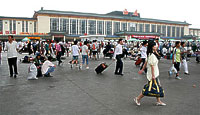 The outside of the station looked like a refugee camp. Hordes of people, most of them in high volume mode, while others tried to sleep in the road, we just wanted to escape from this frenzied scene.
The outside of the station looked like a refugee camp. Hordes of people, most of them in high volume mode, while others tried to sleep in the road, we just wanted to escape from this frenzied scene.
We spied a McDonalds and exited the station compound rapidly. Who would have thought that Ronnie’s would become a place of refuge? Jodie sat the old man down while she went off to get the order.
Jodie was as pleased as punch when returning with a McMuffin with no cheese, and a decent cup of “English” tea with “proper” milk. It’s difficult enough trying to get that in the UK without mishap. With a language barrier to contend with, the feat was even more impressive.
We were staying at the New World Hotel, near the West Gate of the city wall, at the immense price of £17.50 a room. The hotel was (allegedly) just 2 klicks away, so easily within walking distance, especially as we had time on our hands before we could check in.
The walk seemed to take forever and later we discovered that it was twice the distance suggested by their website, although well worth the exertions. Jo held the map and did a beautiful job of getting us to the hotel.
The hotel was impressive and would put most English hotels to shame, so the price we were paying made the experience more enjoyable.
Although we arrived early, we were allowed to register and use the rooms. That gave us all the opportunity of a shower and nap before the planned midday trek along the city wall.
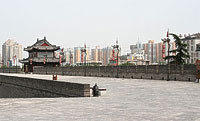 The Xian City Wall represents a historic monument to the Chinese dominance of the period. It's the most complete city wall that has survived in China, as well being one of the largest ancient military defensive systems in the world and the best preserved.
The Xian City Wall represents a historic monument to the Chinese dominance of the period. It's the most complete city wall that has survived in China, as well being one of the largest ancient military defensive systems in the world and the best preserved.
The city wall was built initially during the old Tang dynasty (618 -907), and Zhu Yuanzhang, the first Emperor of the Ming Dynasty (1368-1644), began to enlarge the wall creating the modern Xian City Wall.
All together, there are 98 ramparts on the wall, which were built to defend against the enemy climbing up the wall. Each rampart has a sentry building, in which the soldiers could protect the entire wall without exposing themselves to the enemy.
On the outer side of the city wall, there are thousands of battlements, from which the soldiers could look out from and shoot at their enemy. On the inner side, parapets were built to protect the soldiers from falling off.
What do mad dogs and Englishmen do? They go out in the flipping midday sun and that’s exactly what we did. It was hot! Even I thought my virgin white legs might turn pink.
The hardest part of the exercise was finding an entrance to the top of the wall. Dodging in and out of the shade from the trees that border the wall, we eventually found one of the gate towers that we thought would gain us access.
While we were searching for a way in, we came across a small group of men enjoying a chat and a drink in the shade. We asked a gentleman, who looked like the gatekeeper, where we had to go. Understandably, none of them understood English. After a lot of hand waving and frustrated attempts to get our question across, he finally understood our question.
To the jeers of his comrades, he marched us across the busy road and took us to the ticket office. He was an amazing gentleman, who made a deeper impression when he refused the tip that Jo offered him. Having made sure that we were comfortable with paying the entrance fee, he scuttled back to his mates; bless him.
With the sun streaming down from above and the heat bouncing off the bricks, our walk along the top of the wall proved very hot. We walked for about an hour, but it was tough going in the heat, so we left the wall to find some refreshments.
We just needed a drink so we found a café off the beaten track. I’m not sure that they had received many western visitors before. No one spoke English, so our pleas that we just needed a drink wasn’t understood as the menu was continually placed in front of us.
Our hostess trio were joined by two lads, who spoke a bit of English (allegedly). The lads helped us place our order before sitting at an adjacent table in case we needed further assistance.
They understood the beer part of our request, but Jodie had to go to the fridge to take the bottle of sprite out to complete our order.
Everyone was very attentive and did everything possible to make us feel at ease.
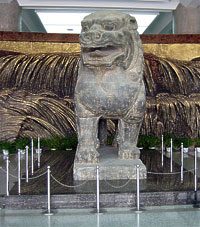 After we left the restaurant, the girls went off to visit a temple while I visited the Shaanxi History Museum, which is one of the best museums in China (allegedly).
After we left the restaurant, the girls went off to visit a temple while I visited the Shaanxi History Museum, which is one of the best museums in China (allegedly).
The museum had a small exhibition of Terracotta Warriors, giving me an appetiser for the day ahead. I walked around for a couple of hours and then felt ready for a beer back at the hotel.
Now, I’m still not as stupid as I look. I had taken a leaflet from the hotel lobby with their name and address in Chinese, so that I could show the driver where I was staying.
The taxis are plentiful and I quickly flagged one down, jumping in the back, and thrusting the hotel leaflet through the grill that separated driver from passenger.
The first cabbie refused me and I was left on the kerbside looking a might confused as he moved on to stop for someone else. I was relieved that he turned them down as well, so I realised it wasn’t personal.
No real problem though as another taxi appeared immediately. I jumped in, gave the driver the leaflet, and waited for his response. Again it was a shake of the head – that international sign indicating a definite no; I’m not going to take this weary westerner to his cold beer.
 This time he added sign language, using his arms to make a rotary motion. Umm, what on earth could that mean? Surely, he wasn’t using the NFL signal for a false start? I guess for me, it was!
This time he added sign language, using his arms to make a rotary motion. Umm, what on earth could that mean? Surely, he wasn’t using the NFL signal for a false start? I guess for me, it was!
You can never put a good man down, so I just waited for the next taxi to pass. I flagged it down, but again the driver refused to take me. This time he dropped a sign down from over his windscreen that said something in Chinese. I had no chance of understanding what it meant, but it also said 1600-1700, which I did understand.
Even I could comprehend what that suggested because the time was ten minutes to five and I assumed that’s why he couldn’t take me. Something happened during that hour, but what could it be?
Having received three rejections, I decided enough was enough. Where’s the bar so I can reflect on my challenge? I walked up and down seeking refuge, but only managed to become more hot and bothered.
I dragged it out until after five and then confidently waved down the next taxi. I jumped in, convinced that finally I would be travelling back for that cold one.
The driver took my hotel leaflet, examined it closely; turned inside to the photos of the restaurant, bar and swimming pool. It didn’t inspire me a great deal and I was ready to get out. I thought here it comes again – another soul-destroying rebuff!
He looked at the front of the leaflet, where the address was, and then pointed at the photo of the hotel and asked, “There?” Well, in truth, it was probably his gesture at the photo that I took as a question. I offered up my cautious affirmative, but as I couldn’t see the image properly, really hoped it was actually a photo of where I wanted to go.
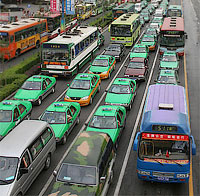 Fortunately, the driver did me proud and just a mere £3 later, I was back at my hotel and headed for that cool refreshing drink I deserved. I sent a text to Jodie warning her about the potential hassle, but the girls had already met the same challenge and eventually, after advice from a local, resorted to taking a bus.
Fortunately, the driver did me proud and just a mere £3 later, I was back at my hotel and headed for that cool refreshing drink I deserved. I sent a text to Jodie warning her about the potential hassle, but the girls had already met the same challenge and eventually, after advice from a local, resorted to taking a bus.
They had gone to the railway station to suss out the left luggage for the next morning. When they failed to get a taxi, a local had advised them that there was a shift changeover between 1600 and 1700. That’s why the taxi drivers were reluctant to go long distances at the end of their shift.
Hence the rotary motion of the hands. It’s obvious, isn’t it? It’s not a false start by the offense! It indicates a shift changeover. Easy, this sign language business.
We eventually all met up and later enjoyed the hotel’s buffet. Steak was my choice (no change there) so I went up to the chef and explained that I wanted it well done, no sign of blood.
As I only managed to obtain blank expressions from them, a waitress was called over because she spoke English (allegedly.)
When she didn’t understand my “no blood” description as I indicated the veins in my arms, another waitress was called over. Her blank expression meant that another waitress was summoned and then finally they called the expert English speaker over, so my troubles would disappear - I would get the steak I was looking forward to.
I thought I had got my requirements registered, especially as I instructed the chef to turn the steak over and over while it was cooking.
Did I heck? It was cooked on the outside lovely, but they were having a laugh with the inside.
Never mind… Jodie did offer to take it back for further cooking, but I was on my second glass of wine by now and didn’t care.
We were up early Saturday morning ready to accept our mission. We went to the train station when the left luggage opened at eight; then onto the next bus out to see the warriors. It would prove to be an interesting and entertaining excursion.
The young conductress spoke English beautifully and with her microphone would inform the passengers as to where they were as the bus stopped occasionally to let people off and on. When we reached the terminal at the museum, the diminutive conductress told us it was our stop.
We trudged across to the ticket office where I hired an audio guidebook to complement the visit. One of the interesting facts I discovered from the audio, is about the chambers being smaller than the Warriors because of the
centuries
of floods, the walls collapsed
Jo had already rtaken note of her guide book’s suggestion to do it in reverse order. That proved very sound advice.
There are three pits numbered, strangely enough, 1, 2 and 3. Our itinerary would be the cinema first, then Pit 3, followed by Pit 2, finishing at Pit 1.
It was a valid plan. We walked into the 360-degree cinema and with only half a dozen people inside, the curtains were drawn and the movie rolled. Fortunately, the sound track was in English as the film told the story of the discovery and the history of the Warriors. It was certainly very impressive, although looking dated.
Pit 3 is the smallest pit and was designed as a command post, where the officers were housed.
Pit 2 is a larger pit containing the archers and chariots divisions of the emperor’s army. On one side of the pit are display cabinets containing warriors and I was waiting to take a photo when a crowd of schoolchildren surrounded me. Shyly, one of them asked me if I spoke English?
When I replied yes, he and his friend began to ask me questions. We managed to break down the barriers of language and generations before the boys finally got around to cautiously asking me if I minded having my photo taken with them.
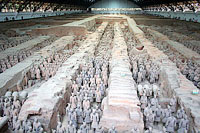 Pit 3 is the largest and the focal point of all the television programmes. It’s the image that everyone remembers about the warriors.
Pit 3 is the largest and the focal point of all the television programmes. It’s the image that everyone remembers about the warriors.
You walk into this huge hall, a cauldron of excitement and marvel. As you begin to appreciate where you are, your eyes discover row upon row of these marvellous terracotta statues. Created thousands of years ago by the emperor to ensure he was protected in the afterlife, they have miraculously survived.
Some call it the eighth wonder of the world, but that compliment is surely deserved for the
skill
of reassembling the broken pottery. The warriors have been patiently pieced together to make them the unique statutes they now are.
A few photos>>>
PAGE 7>>>
CHINA INDEX>>>
PAGE 5>>>